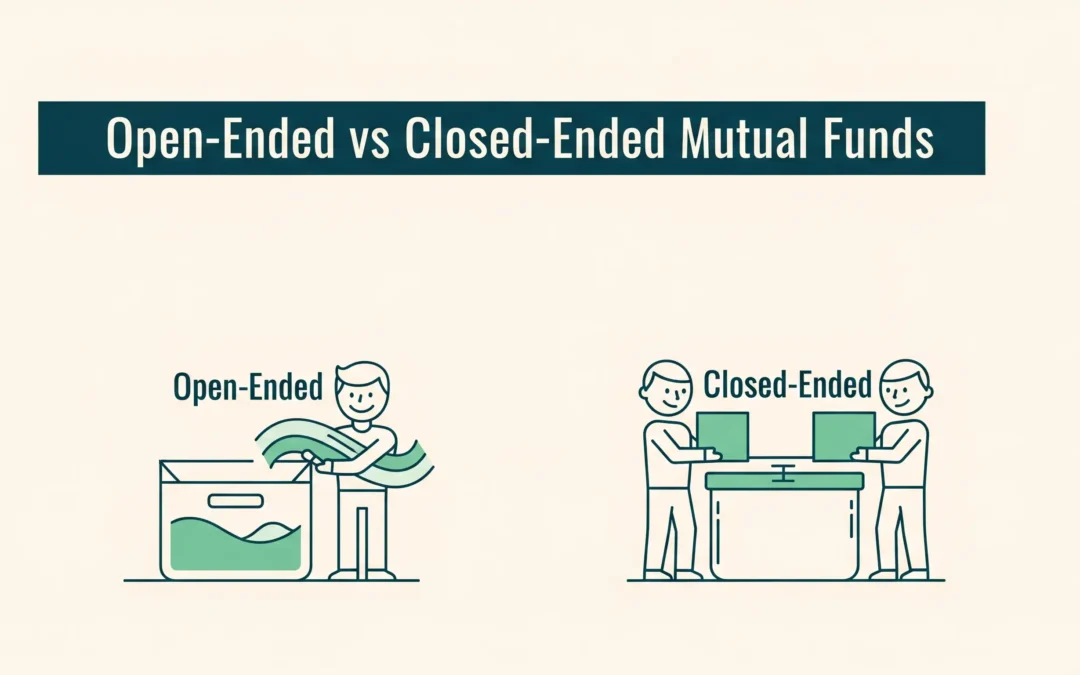There are different types of investors with various investment needs and objectives. To satisfy the majority of them, many mutual fund options are provided, like open-ended and closed-ended funds. Each has its own pros and cons, varying in suitability and liquidity. But how should an investor decide which one to choose? Which one matches their financial objective the best? Which one will yield decent returns with the amount of risk they are willing to take?
Before understanding the difference between them, let us first know the meaning, features, and pros and cons associated with them. This article will help you in learning the difference between the two.
What is an Open-Ended Mutual Fund?
Investors can purchase or sell units of an open-ended mutual fund at any time, even after the New Fund Offer (NFO) period has ended. These funds are always available for investment and redemption, and transactions are conducted in accordance with the fund’s Net Asset Value (NAV), which is announced at the conclusion of each business day.
Key Features:
- Units are always available for purchase or redemption.
- Priced according to the fund house’s declared daily NAV.
- There is no cap on the number of investors or the size of the fund.
- It offers high liquidity to the investor.
- Open-ended mutual funds typically have portfolios managed by qualified fund managers, and can be actively or passively managed depending on the scheme.
Pros:
- High liquidity: Investors can buy or sell units as per their choice, making these funds suitable for medium- to long-term horizons depending on the fund category.
- Flexibility and SIP: Facilitates consistent small-scale investing by supporting regular investments through SIPs.
- Transparency of NAV: The Net Asset Value (NAV) of the fund is calculated and published at the end of each business day, allowing investors to track daily performance.
- An Investor-Friendly Framework: Beginners and risk-averse investors can benefit from its ease of entry and exit.
Cons:
- Impact of Market Fluctuation: Emotional investing may result from daily price fluctuations that trigger panic during volatility.
- Redemption Pressure: Fund managers may have to restrict long-term wagers in order to maintain liquidity for withdrawals.
- Temporary Exits: Easy exit options may encourage frequent redemption, which can impact the fund’s stability and potentially affect long-term returns.
What is a Closed-Ended Mutual Fund?
These funds require the purchase to happen only during the NFO period. Investors can only redeem units of these funds at the end of their fixed maturity period, which is typically three to five years. However, the units are listed on the exchange, which enables buying and selling like normal shares.
Key Features:
- Limited subscription only during NFO.
- Fixed maturity period and fund size.
- Traded following NFO on stock exchanges.
- There is a difference between NAV and market price because of supply and demand on the exchange.
- Often designed with fixed maturity periods, closed-ended funds can suit investors interested in long-term or thematic investment strategies.
Pros:
- Consistent Investment Prospects: Fund managers can invest in long-term opportunities without interruption thanks to locked-in capital.
- Investor Discipline: It promotes discipline as investors cannot prematurely sell due to emotional influence, and it helps in building wealth.
- Exchange-tradable: Before they mature, units have some flexibility because they are listed on stock exchanges.
Cons:
- Restricted Redemption Choice: Redemption directly from the fund is available only at maturity; however, units may be bought or sold on stock exchanges before maturity, though liquidity and prices can be variable.
- The cost may vary from NAV: Because of supply and demand in the market, units may trade at a premium or a discount.
- Absence of SIP availability: During NFO, only lump sum investments are permitted, which limits small investors’ options.
Comparison: Open-Ended vs Closed-Ended Mutual Funds
Your investment objectives, time horizon, and risk tolerance will all influence your decision.
Think about open-ended funds if:
- You desire easy access and exit.
- You are new to investing or a SIP investor.
- You appreciate monitoring performance every day.
- Liquidity is necessary for short-term objectives.
Think about closed-ended funds if:
- You have a set amount of time (3–5 years) to commit funds.
- You support long-term themes (pharma, infra, etc.).
- You have faith in the long-term goals of the fund manager.
- Lower liquidity is acceptable to you.
| Parameter | Open-Ended Fund | Closed-Ended Fund |
| Investment Period | Continuous | Only during NFO |
| Liquidity | High – Can be redeemed anytime | Limited – Redemption only after maturity or on exchange |
| NAV Pricing | Based on daily NAV | NAV available, but traded price may differ |
| Fund Size | Keeps changing with inflows/outflows | Fixed after NFO |
| SIP Facility | Available | Not available |
| Exchange Listing | Not required | Listed on the stock exchange |
| Ideal For | New and regular investors seeking flexibility | Long-term investors are comfortable with lock-in |
Bottomline
The conclusion can be drawn that both open-ended and closed-ended mutual funds have their own target investors who will benefit the most from them. Open-ended funds are for people who want high liquidity, i.e., easy entry and exit. It also suits the needs of new investors who are willing to start an SIP.
However, individuals who don’t mind a long lock-in period and are comfortable investing the extra cash prefer closed-ended funds. The need for liquidity is less in this case.


